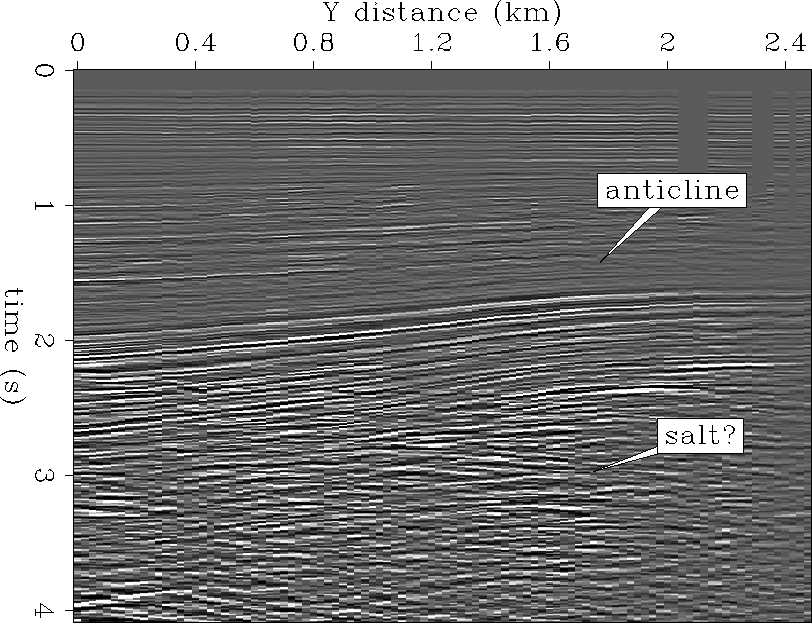




Next: Impulse responses
Up: DATA EXAMPLE
Previous: DATA EXAMPLE
The marine data are a 3-D DMO'ed poststack
data volume acquired over a salt intrusion in the Gulf of Mexico,
donated by Halliburton Geophysical Services to SEP. The test data set
used here is a smaller portion of the complete data set. I am using
30,000 poststack traces binned on a 300x100 surface grid, with a
decimated inline (300) spacing of 37.5 m and an original crossline (100)
spacing of 25 m, representing a surface area of 11 km inline by 2.5 km
crossline. The traces were decimated to 8 ms to save memory, without
loss of signal bandwidth.
Figures ![[*]](http://sepwww.stanford.edu/latex2html/cross_ref_motif.gif) and
and ![[*]](http://sepwww.stanford.edu/latex2html/cross_ref_motif.gif) show a crossline and inline
section respectively, sliced from near the center of the input stacked data
volume. The crossline section shows a sedimentary anticline over some
rough diffractions related to salt. The inline section shows fairly
gently dipping sediments abutting a region of steep dip diffractions and
reflections associated with salt-sediment interfaces.
show a crossline and inline
section respectively, sliced from near the center of the input stacked data
volume. The crossline section shows a sedimentary anticline over some
rough diffractions related to salt. The inline section shows fairly
gently dipping sediments abutting a region of steep dip diffractions and
reflections associated with salt-sediment interfaces.
ysection-ann
Figure 2 Crossline section from
near the center of the input stacked data volume. Notice the
sedimentary anticlinal structure uplifted by the underlying salt
(rough diffraction region).




 xsection
xsection
Figure 3 Inline section from near
the center of the input stacked data volume. The strong diffraction
and steep-dip reflection energy is associated with salt-sediment
interfaces. Some weak evidence of shallow faulting is seen at 8 km
distance at 1.5 seconds.










Next: Impulse responses
Up: DATA EXAMPLE
Previous: DATA EXAMPLE
Stanford Exploration Project
11/17/1997
![[*]](http://sepwww.stanford.edu/latex2html/cross_ref_motif.gif) and
and ![[*]](http://sepwww.stanford.edu/latex2html/cross_ref_motif.gif) show a crossline and inline
section respectively, sliced from near the center of the input stacked data
volume. The crossline section shows a sedimentary anticline over some
rough diffractions related to salt. The inline section shows fairly
gently dipping sediments abutting a region of steep dip diffractions and
reflections associated with salt-sediment interfaces.
show a crossline and inline
section respectively, sliced from near the center of the input stacked data
volume. The crossline section shows a sedimentary anticline over some
rough diffractions related to salt. The inline section shows fairly
gently dipping sediments abutting a region of steep dip diffractions and
reflections associated with salt-sediment interfaces.

